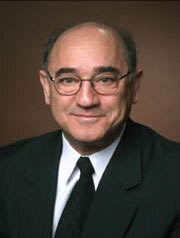by
Bradley Rose, Senior Designer | August 21, 2007

Alex Pines is a leading
expert on magnetic resonance
imaging (MRI) and the basic
technique underlying MRI:
nuclear magnetic resonance
(NMR).
Alex Pines, a faculty scientist at Lawrence Berkeley National Laboratory (LBNL), is a leading expert on magnetic resonance imaging (MRI) and the basic technique underlying MRI: nuclear magnetic resonance (NMR). MRI and NMR take advantage of the fact that molecules in a magnetic field reveal their environment when zapped with radio waves. Chemists use the technique to discover the conditions inside a liquid or solid, while doctors use it to distinguish between tissues in the body.
The need for a large and powerful magnet and expensive support systems limits MRI's use, however, and this spurred Pines to invent innovative ways of improving the information obtainable from nuclear magnetic resonance while decreasing the size of the magnet. Pines and his colleagues won the award for laser-detected MRI - a major breakthrough that eliminates the need for a high-field magnet, making the technology accessible to new users and applications.
This new technology could soon enable MRI to image a wide range of phenomena, from petroleum reservoirs and other samples to very small objects such as tissue samples and microfluidics. In contrast to a typical high-field MRI system that might cost $1 million and weigh 10,000 pounds, the so-called Laser-Detected MRI might sell for $30,000 and weigh less than 100 pounds. Pines' colleagues include LBNL scientists Dmitry Budker, also a UC Berkeley associate professor of physics; Marcus Donaldson; Simon Rochester; Shoujun Xu and Valeriy Yashchuk.
